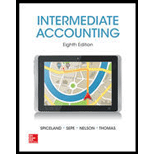
Error correction:
Error correction is an adjustment to previously issued financial statements. It is not considered as an accounting change.
To Journalize: Entry necessary to correct the error, and
Explanation of Solution
| Date | Account Title and Explanation | Debit Amount($) | Credit Amount($) |
| 61,000 | |||
| Interest expense (1) | 61,000 | ||
| (To record error found before adjustment) |
Table (1)
- Retained earnings are component of shareholders’ equity. There is a decrease in the value of shareholders’ equity. Therefore, it is debited.
- Interest expense is a liability. There is an increase in liability value. Therefore, it is credited.
Adjusting entry for the year 2016
| Date | Account Title and Explanation | Debit Amount($) | Credit Amount($) |
| Interest expense (1) | 61,000 | ||
| Discount on bonds payable(2) | 1,000 | ||
| Interest payable(3) | 60,000 | ||
| (To record error discovered before adjustment) |
Table (2)
- Interest expense is a liability. There is a decrease in liability value. Therefore, it is debited.
- Discount on bonds payable and notes payable are liability. There is an increase in liability value. Therefore, it is credited.
- Interest payable is a liability which is increased; hence credit the interest payable.
Journal entries that should have been recorded:
Adjusting entry for the year 2015
| Date | Account Title and Explanation | Debit Amount($) | Credit Amount($) |
| Interest expense(1) | 61,000 | ||
| Discount on bonds payable(2) | 1,000 | ||
| Interest payable(3) | 60,000 | ||
| (To record error discovered before adjustment) |
Table (3)
- Interest expense is a liability. There is a decrease in liability value. Therefore, it is debited.
- Discount on bonds payable and notes payable are liability. There is an increase in liability value. Therefore, it is credited.
- Interest payable is a liability which is increased; hence credit the interest payable.
Journal Entry for the year 2016
|
Date |
Account Title and Explanation | Debit Amount($) | Credit Amount($) |
| Interest expense(4) | 12,200 | ||
| Interest payable(3) | 60,000 | ||
| Discount on bonds payable(5) | 200 | ||
| Cash(Given) | 72,000 | ||
| (To record the correct entry) |
Table (4)
- Interest expense is a liability. There is a decrease in liability value. Therefore, it is debited.
- Interest payable is a liability which is decreased; hence debit the interest payable.
- Discount on bonds payable is a liability which is increased; hence credit the discount on bonds payable.
- Cash is being paid, cash is an asset which is being decreased; hence credit the cash account.
Working notes:
a. Calculate the interest expense for the year 2015
b. Calculate discount on bonds payable for the year 2015
c. Calculate the interest payable for both the years of 2015 and 2016
d. Calculate the interest expense for the year 2016 up to February 1.
e. Calculate the discount on bonds payable for the year 2016 up to February 1.
Interest expenses of 2016 are overstated by recording extra interest in the month of February. Likewise, retained earnings are overstated by the exact amount as the interest expense of 2015 was understated when the accrued interest was not reported.
Want to see more full solutions like this?
Chapter 20 Solutions
INTERMEDIATE ACCOUNTING
- Hillwood Textiles computes its plantwide predetermined overhead rate annually based on direct labor hours. At the beginning of the year, it was estimated that 42,000 direct labor hours would be required for the period's estimated level of production. The company also estimated $525,000 of fixed manufacturing overhead cost for the coming period and variable manufacturing overhead of $3.00 per direct labor hour. Hillwood’s actual manufacturing overhead cost for the year was $670,000, and its actual total direct labor hours were 43,200. Compute the company’s plantwide predetermined overhead rate for the year.arrow_forwardAccurate Answerarrow_forwardElizabeth Appliance Company had a net income of $68,400 and net sales of $480,000. Compute the relationship of net income to net sales.arrow_forward
- Using the weighted-average valuation method the equivalent units produced by the department were _________Units.arrow_forwardI am looking for the correct answer to this general accounting question with appropriate explanations.arrow_forwardPlease help me solve this general accounting question using the right accounting principles.arrow_forward

 AccountingAccountingISBN:9781337272094Author:WARREN, Carl S., Reeve, James M., Duchac, Jonathan E.Publisher:Cengage Learning,
AccountingAccountingISBN:9781337272094Author:WARREN, Carl S., Reeve, James M., Duchac, Jonathan E.Publisher:Cengage Learning, Accounting Information SystemsAccountingISBN:9781337619202Author:Hall, James A.Publisher:Cengage Learning,
Accounting Information SystemsAccountingISBN:9781337619202Author:Hall, James A.Publisher:Cengage Learning, Horngren's Cost Accounting: A Managerial Emphasis...AccountingISBN:9780134475585Author:Srikant M. Datar, Madhav V. RajanPublisher:PEARSON
Horngren's Cost Accounting: A Managerial Emphasis...AccountingISBN:9780134475585Author:Srikant M. Datar, Madhav V. RajanPublisher:PEARSON Intermediate AccountingAccountingISBN:9781259722660Author:J. David Spiceland, Mark W. Nelson, Wayne M ThomasPublisher:McGraw-Hill Education
Intermediate AccountingAccountingISBN:9781259722660Author:J. David Spiceland, Mark W. Nelson, Wayne M ThomasPublisher:McGraw-Hill Education Financial and Managerial AccountingAccountingISBN:9781259726705Author:John J Wild, Ken W. Shaw, Barbara Chiappetta Fundamental Accounting PrinciplesPublisher:McGraw-Hill Education
Financial and Managerial AccountingAccountingISBN:9781259726705Author:John J Wild, Ken W. Shaw, Barbara Chiappetta Fundamental Accounting PrinciplesPublisher:McGraw-Hill Education





